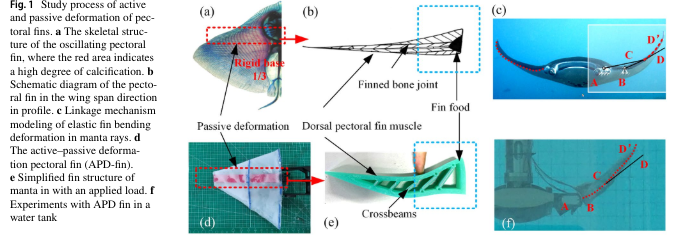Journal of Bionic Engineering (2024) 21:718–728 https://doi.org/10.1007/s42235-023-00463-6
Efect of Active–Passive Deformation on the Thrust by the Pectoral Fins of Bionic Manta Robot Yang Lu1,2 · Shaomin Meng3,4 · Cheng Xing1,2 · Yiwei Hao1,2 · Yonghui Cao1,2 · Guang Pan1,2 · Yong Cao1,2
1 School of Marine Science and Technology, Northwestern Polytechnical University, Xi’an 710072, China 2 Unmanned Vehicle Innovation Center, Ningbo Institute of NPU, Ningbo 315103, China 3 State Key Lab of Fluid Power and Mechatronic Systems, School of Mechanical Engineering, Zhejiang University, Hangzhou 310027, China 4 Zhejiang Key Laboratory of Advanced Manufacturing Technology, School of Mechanical Engineering, Zhejiang University, Hangzhou 310027, China
AbstractBionic manta underwater vehicles will play an essential role in future oceans and can perform tasks, such as long-duration reconnaissance and exploration, due to their efcient propulsion. The manta wings’ deformation is evident during the swimming process. To improve the propulsion performance of the unmanned submersible, the study of the deformation into the bionic pectoral fn is necessary. In this research, we designed and fabricated a fexible bionic pectoral fn, which is based on the Fin Ray? efect with active and passive deformation (APD) capability. The APD fn was actively controlled by two servo motors and could be passively deformed to variable degrees. The APD fn was moved at 0.5 Hz beat frequency, and the propulsive performance was experimentally verifed of the bionic pectoral fns equipped with diferent extents of deformation. These results showed that the pectoral fn with active–passive deformed capabilities could achieve similar natural biological deformation in the wingspan direction. The average thrust (T) under the optimal wingspan deformation is 61.5% higher than the traditional passive deformed pectoral fns. The obtained results shed light on the design and optimization of the bionic pectoral fns to improve the propulsive performance of unmanned underwater vehicles (UUV).
Keywords Manta ray · Bionic pectoral fn · Fin Ray? efect · Active–passive deformation (APD)

Copyright © 2024 International Society of Bionic Engineering All Rights Reserved
吉ICP备11002416号-1









